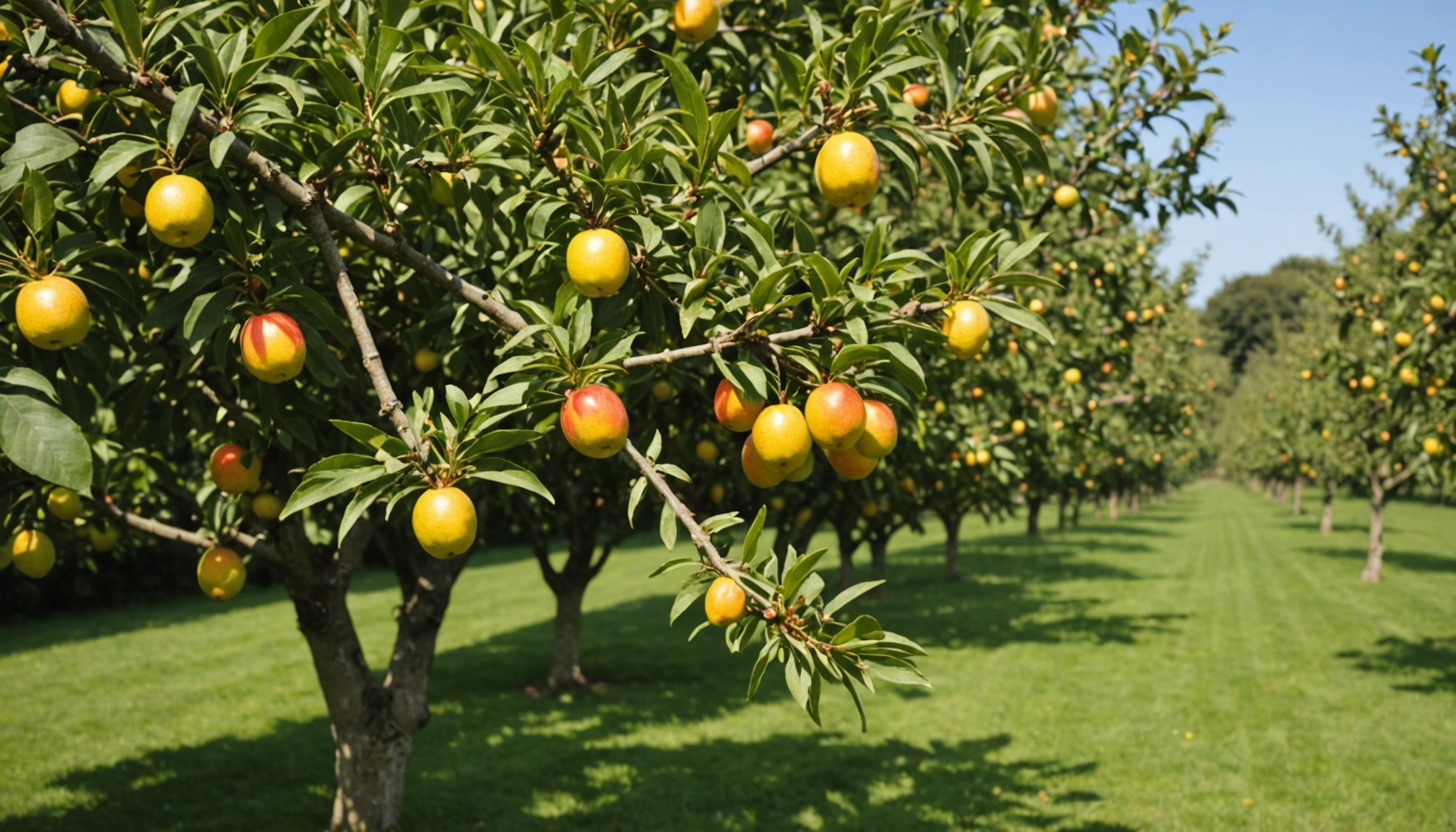Understanding the Importance of Pruning Fruit Trees
The art of pruning fruit trees is vital for enhancing their overall health and fruit yield. Pruning involves carefully removing certain parts of the tree, such as branches or buds, to promote a desired growth pattern and manage the health of the tree. This process is integral not just for aesthetics, but primarily for tree health and optimizing the quantity and quality of fruit produced.
One of the most significant aspects of pruning is its effect on tree growth and fruit production. By eliminating dead or overgrown branches, pruning redirects the tree’s energy towards producing more fruitful and healthy growth. Regular pruning helps control the size and shape of the tree, ensuring better light penetration and air circulation through the branches, which is essential for preventing infections and pests that can damage the tree.
In parallel : Maximizing Space: Designing the Ultimate Permaculture Garden Layout for Your UK Suburban Home
Seasonal pruning is crucial for safeguarding the tree’s well-being year-round. Different seasons call for specific pruning actions, making it important to understand the tree’s life cycle. For instance, certain types of cuts can invigorate a tree in the spring, while fall pruning can prepare it for dormancy. Regular pruning ensures trees remain robust and capable of producing high yields, making it a fundamental practice for any fruit tree caretaker.
Ideal Seasons for Pruning Different Types of Fruit Trees
Timing your pruning efforts to align with the seasonal requirements of different fruit trees is crucial for maximizing their health and fruit yield. Understanding when to prune ensures that you don’t inadvertently stress the tree, which can happen if pruning occurs outside the ideal season. Pruning seasons can differ based on the type of fruit tree and the specific climate conditions they are exposed to.
Also read : Discover versatile camo netting options in our online shop
Stone Fruit Trees
Stone fruit trees, such as cherries and peaches, benefit from pruning in late winter to early spring. This timing helps avoid infection from fungal diseases that can occur during wetter seasons.
Pome Fruit Trees
For pome fruits like apples and pears, late winter is ideal for pruning. This allows the tree to recover and grow vigorously during the spring when temperatures rise.
Berry Bushes
Berry bushes have unique pruning needs. For instance, raspberries and blackberries should be pruned after fruiting. Knowing these timing nuances helps ensure the bushes remain productive year after year.
Aligning pruning activities with the seasonal needs of each fruit type ensures optimal tree health and robust fruit production, making timing a key component of effective tree care practices.
Regional Variations in Pruning Practices Across the UK
In the United Kingdom, regional differences impact pruning practices due to diverse climate variations across specific regions. Coastal areas, such as Cornwall, benefit from milder winters and may begin pruning earlier, whereas northern regions like Scotland experience harsher conditions, delaying pruning activities to prevent tree damage.
Observations of Local Practices
Local practices adapt to the unique climate of each region, directly affecting pruning methods. In England’s southeast, warmer and drier conditions afford greater flexibility in pruning techniques, enabling more proactive approaches to shaping tree growth patterns. Conversely, regions like Wales and Northern Ireland, known for their significant rainfall, require strategic timing to minimise exposing trees to excessive moisture, reducing the risk of fungal infections.
Customizing Pruning Schedules
Ensuring tree health and fruit yield demands customizing pruning schedules. Regions with distinct weather patterns need tailored approaches for optimal results. For instance, in Scotland, delayed spring pruning accommodates prolonged winters, whereas Kent’s orchards may capitalise on early pruning, boosting growth before summer. These regional variations illustrate the importance of understanding local climates and adjusting tree care practices accordingly, promoting healthier and more productive trees throughout the UK.
Effective Pruning Techniques
When it comes to effective pruning, selecting the right techniques is crucial for overall tree care and achieving optimal results. Understanding the appropriate pruning methods can significantly boost tree health and fruit yield, ensuring longevity and productivity in your orchard.
Proper Tools for Pruning
Having the correct tools is fundamental. Essential pruning tools include hand shears, loppers, and pruning saws, each chosen based on the size and type of branches you intend to cut. Sharp, clean tools ensure precise cuts, minimizing damage and promoting quicker healing.
Pruning Cuts and Their Effects
Different cuts serve distinct purposes. Thinning cuts remove entire branches back to their origin, enhancing light penetration and air circulation. Meanwhile, heading cuts shorten branches, stimulating new growth. Understanding these effects allows for strategic shaping and growth management.
Timing Techniques
Timing is everything in pruning. Knowing when to implement specific techniques can maximise growth and yield. For instance, winter pruning invigorates fruit trees, promoting robust spring growth due to the energy conserved while they are dormant.
Utilizing the right tools and methods, along with precise timing, empowers tree caretakers to craft healthier and more productive trees, ensuring a bountiful harvest season after season.
Common Mistakes to Avoid When Pruning
Navigating the world of pruning can be tricky for beginners, leading to frequent errors that can cause significant harm to trees. Improper pruning often hinges on timing mistakes, such as pruning too late in the season. This can stress trees, hindering tree health and reducing their ability to ward off infections. Familiarise yourself with optimal seasons to avoid such issues.
Another prevalent mistake is neglecting the use of clean, sharp tools. Dull or dirty tools can create ragged cuts, which are more susceptible to disease, slowing healing and affecting overall tree growth. Ensure tools are regularly maintained for effective cuts.
Moreover, over-pruning can be detrimental, leading to reduced fruit yield and threatening the tree’s structural integrity. It’s vital to understand the purpose of each cut, exercising restraint to prevent excessive removal of foliage or branches.
For effective pruning:
- Avoid “topping” trees, a practice that stunts growth;
- Apply appropriate techniques, considering branch size and placement;
- Follow best practices by observing the natural shape of the tree for guidance.
By being mindful of these pruning mistakes, you can enhance your pruning skills, promote healthy tree growth, and enjoy abundant harvests.
The Impact of Climate on Pruning
Understanding climate is critical for making informed decisions when it comes to pruning. Seasonal weather patterns have a direct influence on the timing and effectiveness of pruning activities, making it vital to tailor schedules to align with local climatic conditions. For instance, during unusually warm winters, trees might start budding earlier, requiring adjustments in pruning schedules to avoid harming new growth.
Adapting pruning techniques goes beyond simply rescheduling. Recommendations include observing annual climate trends to anticipate changes and prepare accordingly. This foresight can prevent tree damage, ensuring they remain robust even as weather patterns shift.
Climate change adds another layer of complexity, challenging traditional pruning practices. As temperatures fluctuate more wildly and rainfall patterns shift, the resilience of fruit trees becomes increasingly dependent on how caretakers adjust their pruning strategies. Observing how trees react to these changes allows for strategic adaptation, safeguarding both tree health and fruit yield.
In summary, whether dealing with a sudden cold snap or an unseasonably warm spell, understanding the impact of climate on pruning processes is essential. By doing so, you can navigate the challenges posed by climate change, promoting healthier trees and ensuring bountiful harvests year after year.
Visual Aids and Additional Resources for Pruning
Visual aids are invaluable for mastering pruning techniques. They provide clarity and bolster understanding, especially for beginners seeking to enhance their pruning proficiency.
Instructional Videos
Instructional videos offer a comprehensive understanding of various pruning methods, demonstrating the correct use of tools and techniques. This dynamic resource allows viewers to witness the steps in action, helping translate textual instructions into practical application. By watching experienced professionals execute precise cuts, novices gain insights into optimising tree health and fruit yield.
Infographics on Pruning Techniques
Infographics distil complex information into visual summaries, highlighting key pruning techniques at a glance. They are an excellent resource for understanding the interplay between pruning, tree structure, and growth patterns. These visual elements simplify the learning process, making it more accessible for gardeners to retain important pruning principles effectively.
Regional Pruning Guides
Regional pruning guides cater to the diverse climate and regional differences affecting tree care practices. These guides provide tailored advice, offering readers the best pruning practices for specific geographical conditions. They often include adaptable schedules and techniques, reflecting local climate considerations to ensure optimal outcomes.
Engaging with these resources empowers tree caretakers by enhancing their skills and ensuring bountiful harvests.











